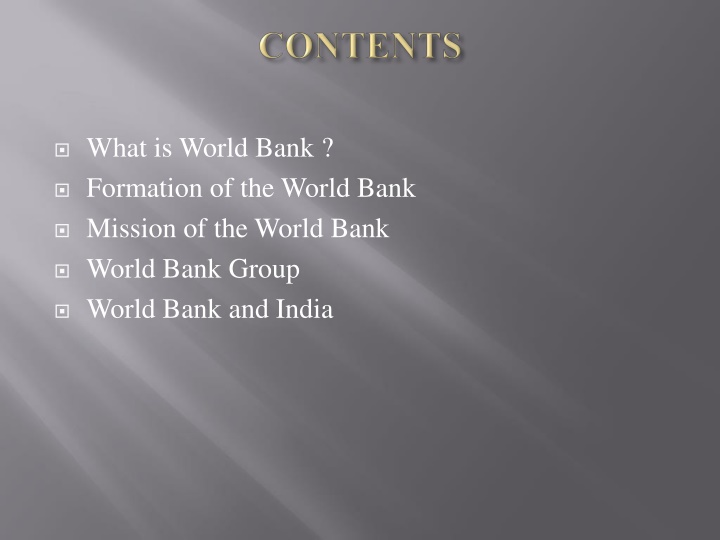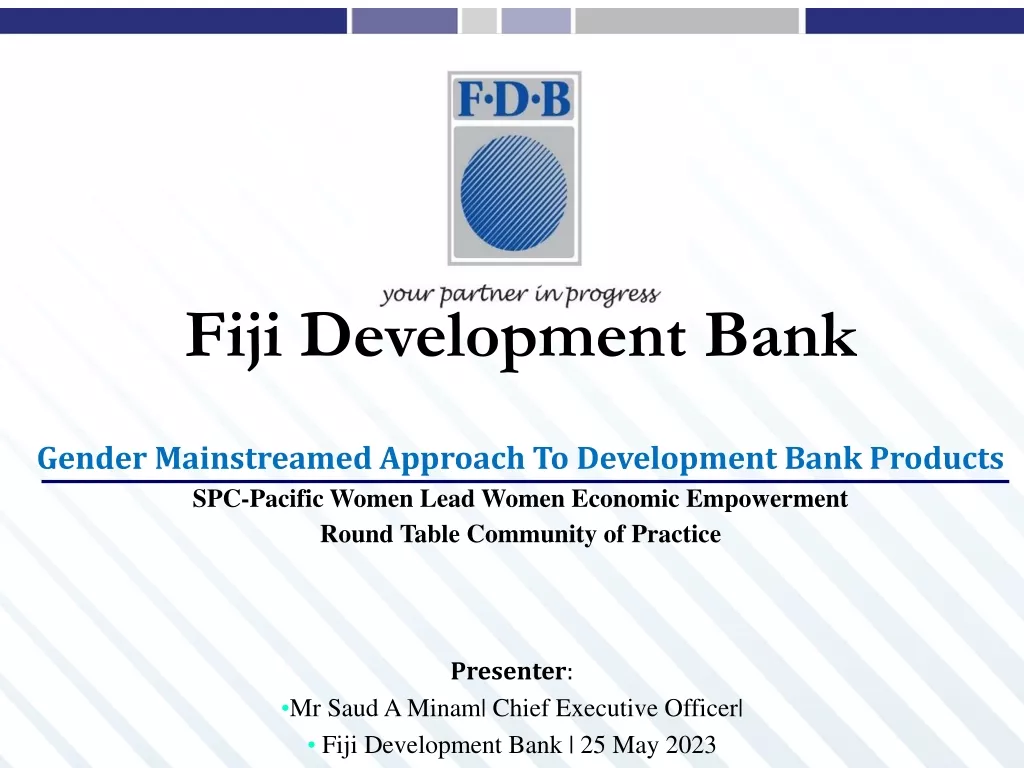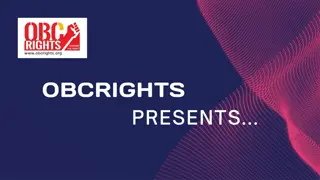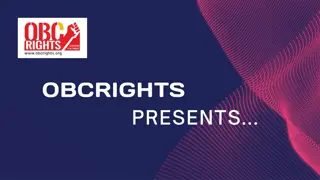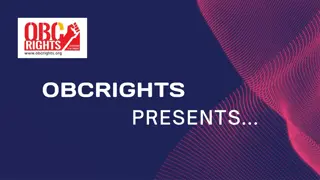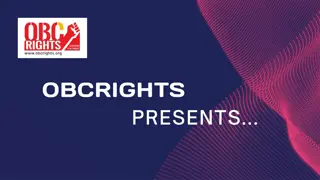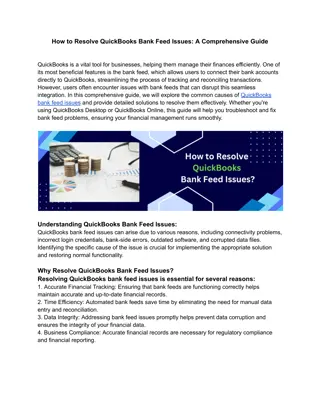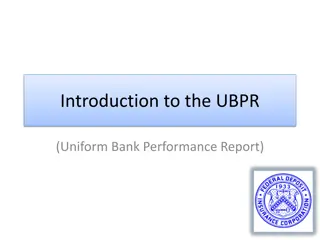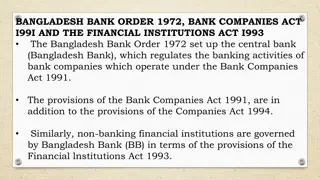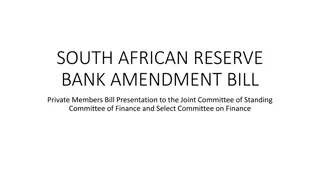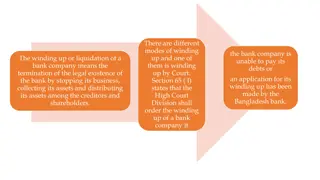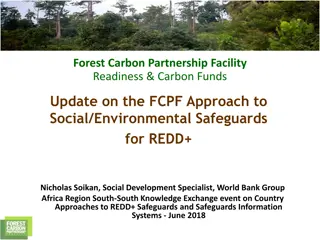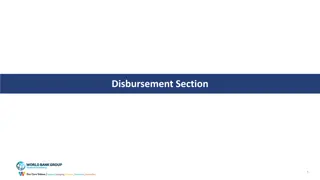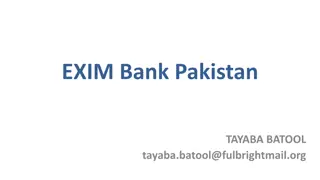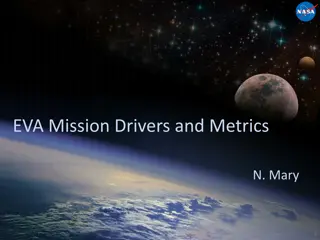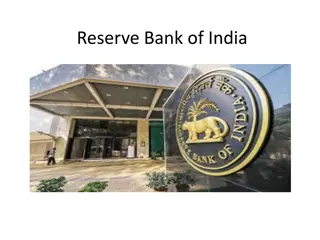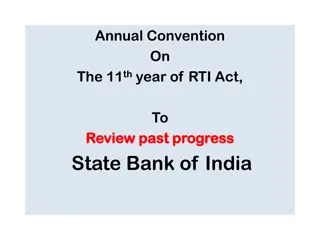Overview of World Bank and Its Mission
The World Bank, formed in 1944 at a UN Conference, is a key global financial institution providing loans and grants to developing nations for capital projects. With a mission to reduce poverty and promote sustainable development, the Bank comprises the IBRD and IDA. The Atal Bhujal Yojana in India is a recent example of its initiatives. The Bank's goal is to end extreme poverty by 2030 and increase shared prosperity.
Download Presentation

Please find below an Image/Link to download the presentation.
The content on the website is provided AS IS for your information and personal use only. It may not be sold, licensed, or shared on other websites without obtaining consent from the author.If you encounter any issues during the download, it is possible that the publisher has removed the file from their server.
You are allowed to download the files provided on this website for personal or commercial use, subject to the condition that they are used lawfully. All files are the property of their respective owners.
The content on the website is provided AS IS for your information and personal use only. It may not be sold, licensed, or shared on other websites without obtaining consent from the author.
E N D
Presentation Transcript
What is World Bank ? Formation of the World Bank Mission of the World Bank World Bank Group World Bank and India
The IMF and World Bank (IBRD) was conceived at a UN Conference of 44 Nations held at Bretton Woods, New Hampshire, United States, in 7 July 1944 primarily by the ideas of Harry Dexter and John Maynard Keynes. These two international institutions are known as Bretton Woods Twins. The world bank is an international financial institution that provides loans and grants to the governments of poorer countries for the purpose of pursuing capital projects.
Atal Bhujal Yojana: GOI and World Bank signed loan agreement to improve groundwater in India. The Atal Bhujal Yojana (ABHY) aims to strengthen the institutional framework participatory groundwater management. associated with
The World Bank is comprised of two bodies: The International Bank for Reconstruction and Development (IBRD) synonymous with the World Bank itself 2. The International Development Association (IDA), added in 1960 The World Bank s first loan was to France for post-war reconstruction, but after decolonization, and as the European countries got back on their feet, the Bank s lending has been more focused on poorer nations. 1. this used to be
Motto: Working for a World free of poverty Formation: July 1944 Headquarters: Washington D.C. U.S Membership: 189 Countries (IBRD), 173 Countries (IDA) President: David Malpass Present Organization: World Bank Group Goal: The world bank s most recent stated goal is the reduction of poverty.
To end Extreme Poverty By reducing the share of the global population that lives in extreme poverty to 3 percent by 2030 The promote shared prosperity By increasing the incomes of the poorest by 40 percent of people in every country.
The World Bank Group is one of the worlds largest sources of funding and knowledge for developing countries. Its five institutions share a commitment to reducing poverty, increasing shared prosperity and promoting sustainable development. The Bank Group works with country governments, the private sector, civil society organizations, regional development banks, think tanks, and other international institutions on issues regarding from climate change, conflict and food security to education, agriculture, finance, and trade.
IBRD (International Bank for Reconstruction and Development) IDA (International Development Association) IFC (International Finance Corporation) MIGA (Multilateral Investment Guarantee Agency) ICSID (International Centre for Settlement of Investment Disputes)
Partnering with Governments Together, IBRD and IDA forms the World Bank, which provides financing, policy advice, and technical assistance to governments of developing countries. IDA focuses on the world s poorest countries, while IBRD assists middle- income and creditworthy poorer countries. Partnering with the Private Sector IFC, MIGA, and ICSID focus on strengthening the private sector in developing countries. Through these institutions, the World Bank Group provides financing, technical assistance, political risk insurance, and settlement of disputes to private enterprises, including financial institutions.
IBRD is the worlds largest development Bank Formation: 1944 Headquarters: Washington D.C Member Countries: 189 countries The International Bank for Reconstruction and Development (IBRD) is an international financial institution that offers loans to middle-income developing countries. The IBRD offers financial products and policy advice to countries aiming to reduce poverty and promote sustainable development.
The IBRD is owned and governed by its member states, but has its own executive leadership and staff which conduct its normal business operations. In addition to contributions from its member nations, the IBRD acquires most of the capital by borrowing on international capital markets through bond issues. The IBRD provides commercial-grade or concessional financing to sovereign states to fund projects that seek to improve transportation and domestic policy, environmental investments, healthcare, access to food and potable water and access to improved sanitation. infrastructure, consciousness education, energy
The International Development Association (IDA) is an international financial institution which offers concessional loans and grants to the world s poorest developing countries. Formation: 24 September 1960 Headquarters: Washington D.C. Member Countries: 173 countries
It was established in 1960 to complement the existing IBRD by lending to developing countries which suffer from the lowest gross national creditworthiness, or from the lowest per capita income. The IDA s stated aim to assist the poorest nations in growing more quickly, equitably, and sustainably to reduce poverty. The IDA lends to countries with the aim to finance projects that will develop infrastructure and improve education, healthcare, access to clean water and sanitation facilities and environmental responsibility. income, from troubled
IDA lends money on concessional terms. This means the IDAcredits have a zero or very low interest charge and repayments are stretched including a 5 to 10 years grace period. IDA also provides grants to countries at risk of debt distress. IDA is one of the largest source of assistance for the world s 75 poorest countries. 39 of which area in Africa, and is the single largest source of donor funds for basic social services in these countries. over 38 years,
IFC is an international financial institution that offers investment, advisory, and asset management services to encourage private sector developed countries. Formation: 20 July 1956 Headquarters: Washington D.C. Member Countries: 184 Countries It was established in 1956, as the private sector arm of the World Bank Group, development by investing in for profit and commercial projects for poverty development. development in less to advance economic reduction and promoting
IFC makes loans to business and private projects generally with maturities of seven to twelve years. Through its Global Trade Finance Program, the IFC guarantees trade payment obligations of more than 200 approved banks in over 80 countries to mitigate risk for international transactions. Program provides guarantees to cover payment risks for emerging market. Banks regarding promissory notes, bills of exchange, letters of credit, bid and performance bonds, supplier credit for capital goods imports and advance payments. IFC raises virtually all funds for lending activities through the issuance of debt obligations in international capital markets. The Global Trade Finance
MIGA is a member of World Bank Group and its mandate is to promote cross-border investment in developing countries by providing guarantees (political risk insurance) to investors and lenders. Formation: 12 April 1988 Headquarters: Washington D.C. Member Countries: 181 countries
MIGA aims to promote foreign direct investment into developing countries to support economic growth, reduce poverty and improve people s lives. MIGA offers insurance to cover five type of non- commercial risks: currency transfer restriction, government expropriation, war, terrorism, and civil disturbance, breaches of contract and the non honoring of financial obligations. inconvertibility and
International Centre for Settlement of Investment Disputes (ICSID) is an international arbitration institution established in 1966 for legal dispute resolution and conciliation between international investors. Formation: 14 October 1966 Headquarters: Washington D.C. Member Countries: 154 countries States have agreed on ICSID as a forum for investor State dispute settlement in most international investment treaties and in numerous investment laws and contracts.
It is an autonomous, multilateral specialized institution to encourage international flow of investment and mitigate non-commercial risks by a treaty drafted by IBRD s executive directors and signed by member countries. ICSID provides for settlement of disputes by conciliation, arbitration or fact-finding.
India was one of the forty-four original signatories to the agreements reaches established the International Bank for Reconstruction and Development (IBRD) Monetary Fund (IMF). It is also one of the founding members of the IFC in 1956 and the IDA in 1960. India later became a member of the MIGAin January 1994. India is not a member of ICSID. India claimed ICSID Convention is not fair, convention's rules for arbitration leaned towards the developed countries. at Bretton Woods that and the International
IBRD lending to India commenced in 1949 with a loan to the Indian railways, the first investment by the IFC in India took place in 1959 and by IDA in 1961 (a highway construction project). During the 1960s and 1970s, the IDA accounted for nearly three-fourths of all WB lending to India and in turn India was by far the largest recipient of IDA funds, accounting for more than two-fifths of all its lending. India is currently classified as Blend country defined as one in transition from lower middle-income to middle-income and its creditworthy for lending from both IDAand IBRD.
India is the largest IBRD client of the World Bank. Between 2015 and 2018, the World Bank lent amount $10.2 billion to India. MIGA performance Standards are environmental and Social Standards which help to structure and implement sustainable projects. For, Indian Market, one of the options is a breach of contract insurance which MIGA would offer to investors. In case the government doesn t perform its obligation, under the contract arrangement, then MIGA can come and cover that risk for investment.
